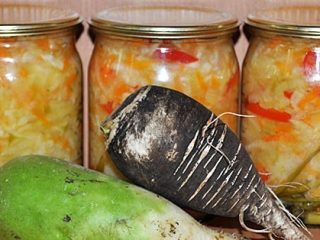Content
Zucchini is versatile in use. They are used fresh to prepare a number of dishes or processed for preservation for the winter. Vegetables are made into caviar, juice, salted, pickled in pure form, or other fruits are added. One of the common processing options is zucchini in tomato juice for the winter with garlic, pepper, carrots and a selection of any spices. A canned product is prepared from fruits of any variety and color.
Selection and preparation of ingredients
For processing for the winter, preference is given to young zucchini; they are used together with the peel, so there should be no dark spots or deep scratches on the surface. If the workpiece is made from ripe fruits, then select specimens without soft areas and signs of rotting. Tomatoes are processed ripe, red varieties. With yellow tomatoes, the product will not taste different, but will turn out to be pale.
Instead of tomatoes, you can use paste; it is diluted with plain water to the desired consistency. The liquid should not be very thick or weakly concentrated. More often, packaged or canned tomato juice is used. It is not diluted with water.
Process zucchini as follows:
- Wash under running water. Remove any remaining moisture from the surface with a napkin.
- Cut off the place of the stalk and receptacle.
- Ripe fruits are cut in half and the pulp and seeds are removed. If necessary, cut off the peel in a thin layer.
Shape the zucchini according to the recipe requirements. Tomatoes are harvested without peels and seeds. If tomato filling is obtained using a juicer, the fruits are only washed first. Twist in a meat grinder.
Zucchini preparations for the winter with tomato juice
After processing, zucchini is closed only in well-washed and sterilized jars. Seal with lids that have previously been boiled for at least 5 minutes. You can make zucchini for the winter with pasta, fresh tomatoes, or use canned tomato juice. It is permissible to add sweet bell peppers, spices and garlic to the recipe.
Classic recipe for pickled zucchini in tomato juice for the winter
Ingredients:
- zucchini – 4 kg;
- tomato juice – 4 l or tomatoes – 6 kg;
- salt – 8 tsp;
- ground pepper – 2 tsp.
How to make zucchini canned in tomato juice for the winter:
- Vegetables are cut into slices. Then they are divided into two parts, and the jars are filled to the top with the blank.
- Pour boiling water over the slices. Place lids on the neck of the container and leave for 15-20 minutes.
- Drain the liquid from the zucchini. She won't be needed anymore.
- Tomatoes are doused with boiling water, peeled, and passed through a meat grinder or juicer.
- Combine tomato juice, salt and pepper in a cooking container. After boiling, stand for 5 minutes.
- Fill containers with pieces of vegetable with boiling tomatoes so that they are completely covered.
The jars are sealed with lids and turned over. Then the workpiece is carefully insulated for the winter. Leave to cool for 24 hours.

The recipe yields 8 liters of finished product
Zucchini in tomato juice without sterilization
Components:
- tomatoes – 700 g;
- garlic – 50 g;
- carrots – 2 pcs. medium size;
- zucchini – 2 kg;
- sugar – 4 tbsp. l.;
- salt – 1 tbsp. l.;
- ground black pepper – ½ tsp;
- vegetable oil – 100 ml;
- vinegar (9%) – 3 tbsp. l.
How to make zucchini for the winter:
- Garlic is divided into cloves and removed from the hard shell. The top layer is removed from carrots, and the peel is peeled from tomatoes.
- All vegetables are passed through a meat grinder.
- Place in a saucepan and cook after boiling for 10 minutes. over medium heat. Stir occasionally.
- Zucchini is formed into rings 2 cm wide.
- Salt, sugar, pepper and sunflower oil are added to the boiling vegetable mass.
- Add zucchini to tomato sauce and cook for 15 minutes. During the process, the cutting will become soft and completely covered with liquid.
Place the pieces in containers and fill them with marinade, seal them, cover them with a blanket or warm jacket, and leave them for a day.

Zucchini for the recipe is taken at milky ripeness
Zucchini lecho with tomato juice
Components:
- tomato juice – 2.5 l;
- zucchini – 4 kg;
- ground red pepper – ½ tsp;
- bell pepper – 5 pcs. (large);
- salt – 30 g;
- sugar – 150 g;
- vegetable oil – 3 tbsp. l.;
- vinegar – 100 ml;
- garlic - 2 heads.
How to prepare lecho for the winter:
- The zucchini is cut in half lengthwise and the seeds and fibers are removed. It is convenient to do this with a spoon. If the vegetables are ripe and have a hard skin, cut it off.
- Form each part into half rings 1-1.5 cm wide.
- Bell peppers are seeded and cut into cubes.
- The garlic is chopped into thin slices with a knife.
- The vegetables are combined and mixed.
- Tomato juice is poured into the cooking container, salt, sugar, pepper and butter are added.
- The mixture is placed on the stove. After boiling, add vinegar.
- Cook the vegetable stock for 7 minutes. Vegetables are sent to the marinade in parts.
- Using a slotted spoon, take out pieces of zucchini and pepper and fill the containers for preservation.
- Boiling tomato juice is poured over the workpiece so that it is completely covered.
The containers are rolled up with lids and turned over. Then wrap it up for complete gradual cooling.

For lovers of spicy snacks, you can include a pod of hot pepper in the recipe.
Storage periods and methods
The shelf life of zucchini prepared for the winter using vinegar is 3 years. If a preservative is not included in the composition - 1-2 years. The opened preparation is placed in the refrigerator; it retains its nutritional value in the marinade for seven days, without vinegar - no more than five days.
Store zucchini in the basement, pantry or on a closed loggia. In the latter case, the temperature in winter should not fall below zero. Support +4-80 C, minimum air humidity so that metal covers are not damaged by corrosion.
Conclusion
Zucchini in tomato juice for the winter is one of the popular ways to process vegetables. The product has a long shelf life; recipes do not require strict adherence to dosage. The heat treatment is short, so the raw material completely retains the chemical composition of fresh fruits. The product is used as an addition to side dishes, served with boiled potatoes or consumed as an independent dish.








